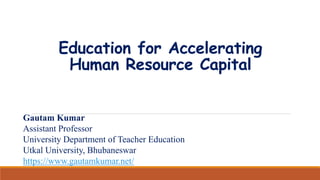
Education for Accelerating Human Resource Capital
- 1. Education for Accelerating Human Resource Capital Gautam Kumar Assistant Professor University Department of Teacher Education Utkal University, Bhubaneswar https://www.gautamkumar.net/
- 2. What are Resources? Resources are anything that has utility and adds value to your life. Air, water, food, plants, animals, minerals, metals, and everything else that exists in nature and has utility to mankind is a ‘Resource’. The value of each such resource depends on its utility and other factors.
- 3. What is Capital? Capital includes the cash and other financial assets held by an individual or business, and is the total of all resources used to leverage growth and build stability. Capital can include funds held in deposit accounts, tangible machinery like production equipment, machinery, storage buildings, and more. Raw materials used in manufacturing are not considered capital. In economics, capital consists of human-created assets that can enhance one's power to perform economically useful work.
- 4. What is capital? Physical Capital: For development and enhancement of physical assets such as buildings, bridges, factories etc. all the inputs like tools, machinery, gadgets which are required are called Physical Capital. Human Capital: Skillset, educational qualifications, subject knowledge, ability and expertise in the human resource of a nation at a point in time is called Human Capital.
- 5. Human Capital • The term human capital formation implies the development of abilities and skills among the population of the country. • According to Harbison, the human capital formation indicates, “the process of acquiring and increasing the number of persons who have the skills, education and experience which are critical for the economic and the political development of the country. Human capital formation is thus associated with investment in man and his development as a creative and productive resource.” • Human Capital, is the backbone of any nation. These human resources mainly consist of students who gradually turn into accountants, engineers or doctors. These students depending on their efficiency and capability become a Human Assets for the country.
- 6. Sources of Human Capital Formation • G.M. Meier defines Human Capital Formation as “human capital formation is the process of acquiring and increasing the number of persons who have education and experience which is essential for the economic and political development of a country”.
- 7. Sources of Human Capital Formation According to T.W. Schultz, there are five ways of developing human resources: 1. Health facilities and services, broadly conceived to include all expenditure that affect the life expectancy, strength and stamina, and the vigour and vitality of the people; 2. In on-the-job training, including aid type apprenticeships organised by firms; 3. Formally organised education at the elementary, secondary and higher levels; 4. Study programmes for adults that are not organised by firms, including extension programmes notably in agriculture; 5. Migration of individuals and families to adjust to changing job opportunities.
- 8. Sources of Human Capital Formation Skills and capabilities of the individual determined by genetic factors and that can be further developed by education and the environment. Education and the environment interact and by the impact of one’s environment in which the individual grows up, as well as by the impact of continuing education (both formal and informal) and by shaping one’s abilities, the individual acquires and develops their competencies and skills
- 9. Sources of Human Capital Formation The most effective way of enhancing and enlarging the productive workforce in the country is the expenditure done on strengthening the education system. It is considered as the best source of human capital formation. The objective of nation and individuals behind investment in education are: • To increase the future income. • Creating manpower and generating their technical skills, which are well suited for improving labour productivity and thus resulting in sustainable rapid economic growth. • Controlling population growth rate which can be done by bringing down the birth rate. This results in more resources available per person. • Education can be floated to others, resulting in social benefit. Expenditure on Education
- 10. Phases of Human Capital / Resources Development Phase 1: Identification and analysis of needs Phase 2: Planning of Education Phase 3: Implementation Phase Phase 4: Evaluation of educational Process
- 11. What is the Knowledge Society? • A society in which the creation, dissemination, and utilization of information and knowledge has become the most important factor of production. In such a society, knowledge assets are the most powerful producer of wealth, sidelining the importance of land, the volume of labour, and physical or financial capital. • It is used interchangeably with notions such as ‘knowledge economy’, ‘knowledge driven economies’, ‘economies of innovation’ and the ‘information society’. • A new society formed as a result of the contemporary societal change pushed by technological innovation and institutional transformation, which is not only about technological innovations, but also about human beings, their personal growth and their individual creativity, experience and participation in the generation of knowledge. The primary role of cities in a knowledge society is to ensure that their knowledge sources are passed on and advanced by each generation.
- 12. Skilled Manpower ? • Skilled: Someone who is skilled has the knowledge and ability to do something well. • Multi-skilled: Multi-skilled employees have a number of different skills, enabling them to do more than one kind of work. • Semi-skilled: A semi-skilled worker has some training and skills, but not enough to do specialized work. • Unskilled: Unskilled manpower refers to the people who are not educated, trained, experienced and are not able to do work without the help of others. • Skill can be a measure of the quantity of worker’s expertise, specialization, income, and supervisory capacity.
- 13. Discussion
